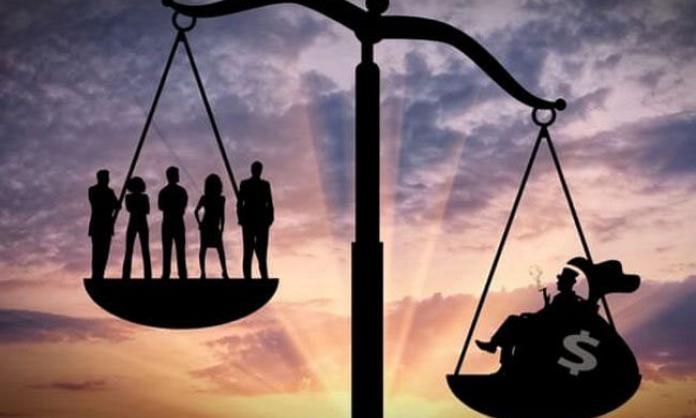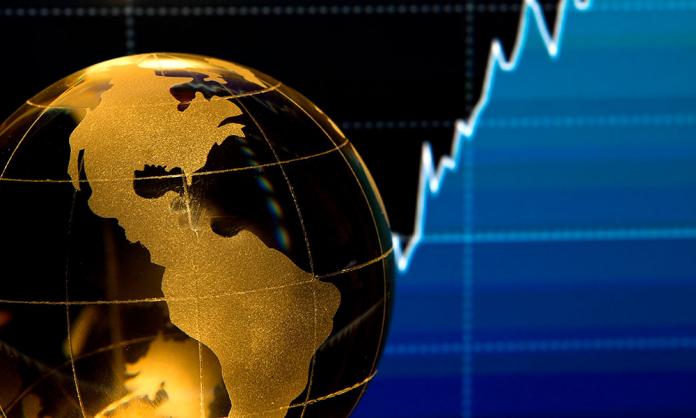At the heart of capitalism’s impressive economic dynamic there is a dirty secret. And it’s a BIG secret.
Capitalism gives rise to crises in many ways because it puts profits before the satisfaction of human needs: floods, bush fires, droughts due to global warming; new diseases and pandemics; and wars. But human suffering on a huge scale recurs in periods of mass unemployment and declining living standards for the bulk of the population for strictly economic reasons.
Economic crises are turds in the custard of capitalist prosperity.
The productivity of human labour has increased enormously under capitalism, driven by the logic of competitive accumulation: investment to make profits to reinvest to continue making profits. This process has led to technological advances like the shift to collect wheat crops with combine harvesters instead of sickles, or communication by video calls instead of letters carried by horses or boats.
In The Communist Manifesto, where Marx and Engels praised this dynamism, they also recognised that capitalism is prone to profound economic crises:
“In these crises, a great part not only of the existing products, but also of the previously created productive forces, are periodically destroyed. In these crises, there breaks out an epidemic that, in all earlier epochs, would have seemed an absurdity—the epidemic of over-production. Society suddenly finds itself put back into a state of momentary barbarism; it appears as if a famine, a universal war of devastation, had cut off the supply of every means of subsistence; industry and commerce seem to be destroyed.”
Later, Marx provided systematic explanations of why the very foundations of capitalist production mean capitalist growth is unstable, fragile and subject to reversals.
Most of the things on which our survival and flourishing depend are commodities, at once use values, which we need to fulfil specific functions, and values, which exchange based on the quantities of human labour embodied in them. That was not the case in pre-capitalist societies, the bulk of whose production was destined for the consumption of producers, rather than sale on a market.
But, as technology advances under capitalism, it is only by accident that the proportions among use values and the proportions among exchange values match, so growth is seldom smooth.
There is also a long-term tendency for the rate of profit to fall and for capitalism to break down. Because of it, the ongoing potential for disrupted production, due to disproportions in the expansion of the number of use values and values, also takes the form of deep crises.
If they are to stay in business, bosses need to make profits. To make profits they must be able to sell the products their workers produce. To do that, they have to compete with other employers selling the same kind of commodities.
The most important, though not the only, way that they compete is by keeping down the price of their products compared to those of their rivals. Keeping the lid on wages and the costs of raw materials is part of this effort. So is investment in new, more expensive machinery and equipment that makes it possible to produce the same or better commodities with less labour.
This competitive accumulation of productive resources means that bosses pay out more and more on machinery and equipment compared to their outlay on labour.
The first bosses who use such a new technology can gain massive profits. Their costs have gone down, but the prices they charge can be set just below those of their competitors still using the old technology, reflecting the average costs of production in the industry. Their profit margins are higher, and their share of the market expands. The innovators get an above average rate of profit.
The problem is that the advantages of being the first to use a new technology do not last forever. Eventually all the bosses in the industry will also adopt it, or they will go out of business. Then the prices charged will reflect the now lower average costs involved in using the new technology. Consequently, the rate of profit of the innovating bosses falls, as does the average rate of profit in the industry.
In 2003, the Wall Street Journal spelt out how this worked with new technology for LCD screen manufacture:
“Since the cost advantages are highest for those who move first, companies have been in a headlong dash to boost manufacturing capacity.”
The corporations that invested in the state-of-the-art plants and got them pumping out screens quickly made big profits, as prices still reflected the fact that the slower corporations were using old-fashioned equipment. But all producers were forced to load “up on advanced new production capacity, anxious to lock in market share” or leave the industry. Pretty soon, profits in the industry fell.
“While price cuts brought on by increased supply stand to be a boon for couch potatoes the world over by putting a flat-screen TV within affordable reach, they threaten to doom the industry to a future of cut-throat competition and slim margins.”
When profits fall, total investment by bosses declines and growth slows. When profits fall far enough, a crisis sets in: growth stops or economies even contract, as firms go out of business, workers are laid off and the overall level of production declines.
Rising living standards give way to lower real wages and/or unemployment for the working class. Capitalism undermines the conditions of its own health—including the reproduction of workers’ capacity to labour , its most precious commodity.
There are “counter-tendencies” to the basic tendency for the rate of profit to fall. Some are automatic. Increased productivity reduces the value of the food, clothing, shelter and other commodities that workers consume. Money wages can stagnate or fall while the cost of living also declines, so workers can still turn up to work properly nourished, clad, healthy and educated. Higher productivity also reduces the value of productive resources, slowing the fall in the rate of profit.
But the effects of these counter-tendencies are necessarily limited. Competition pushes bosses to invest money saved by them in more expensive, but labour-saving, technologies.
Other mechanisms can boost profits for a while too. During crises, bankrupt capitalists sell their productive resources at bargain prices. With lower costs, the new owners can now produce at a profit.
Bosses can intensify exploitation by cutting wages or intensifying work, to raise the share of profits in total output. Attacks on trade unions and the use of racism by bosses and governments to divide and weaken workers’ capacity to resist help increase profits at the expense of wages.
The discovery of new sources of cheaper raw materials can boost profits too. By engaging in imperialist trade and investment policies, states can improve the profits of locally based businesses at the expense of those in other countries.
Large amounts of profits invested in unproductive industries like armaments, which do not produce commodities that go back into the production process, can stabilise the rate of profit under some circumstances. That happened during the Cold War.
These counter-tendencies mean that capitalism does not simply break down once and for all, as the rate of profit declines month by month, year by year. Instead, the alternation of periods of custard prosperity with periods of turds of stagnation is typical of the system.
To understand the state of the economy at any time, we have to assess the balance between the tendency for the rate of profit to fall and its counter-tendencies. But we also have to consider shorter term factors that influence profits and give rise to the business cycle.
In a recession, prices of commodities—including the price of labour power, wages—fall below their value, profits slump and workers are laid off. Eventually, in the initial phase of an economic recovery some capitalists need to renew their fixed capital (buildings, machinery or other equipment) if they are to stay in business. They take advantage of rates of profit improved by lower costs and tentatively expand their output and investment. Their employment of idle productive capacity and labour power can stimulate other sectors which supply them with inputs or produce the kinds of commodities that workers consume.
As the economy gathers pace, there is greater competition for workers, raw materials and credit. This increased demand puts upward pressure on prices, which rise above the value of their commodities, and interest rates. The extent to which wages rise also depends on the extent to which workers fight for increased pay. But as new investments increase capacity and output, prices slide back towards commodities’ values, and profits decline.
Eventually, as profits are eroded, the economy becomes more vulnerable to shocks that can trigger a recession. The oil shock, when Middle Eastern countries pushed up the price of this strategic commodity, was an important factor in setting off the deep recession of the mid-1970s. The collapse of extremely risky mortgage finance providers, then the investment bank Bear Sterns, which speculated in mortgage-backed securities, then Lehman Brothers bank, led to the Global Financial Crisis of 2007-2009.
The depths and durations of downturns will be conditioned by the longer-term movements in the rate of profit. During the long postwar boom, from the late 1940s through to the early 1970s, recessions were generally short and shallow. Since then, growth has been more uneven. The Global Financial Crisis was the most severe recession since the Great Depression of the 1930s. In 2020, COVID plunged the world into the steepest international economic downturn ever.
There are additional complications to consider when assessing economic situations, beyond the tendency for the rate of profit to fall and the business cycle. They are consequences of uneven capitalist development internationally.
The Global Financial Crisis, for example, did not have the same intensity in every country. It affected China and consequently one of its main raw materials suppliers, Australia, much less than the rest of the world.
In the face of intensified international competition for declining sales, many Chinese industries had the advantage of investments in more recent and efficient technologies, along with relatively cheap but skilled labour. Chinese purchases of Australian iron ore, coal and educational services remained robust.
Making economic predictions is a very uncertain activity, even when based on systematic, concrete analysis. But we can be confident of the conclusion that crises are unavoidable.
Capitalists decide their levels of output and investment using forecasts that are not consistently reliable. Competition among them makes it impossible to reliably plan production to achieve proportional growth in all sectors and avoid crises. It is not in their interests to disclose the details of their operations to rivals, state regulators or international institutions. And they cannot escape the logic of the tendency for the rate of profit to fall.
The unavoidable economic contradictions of their system mean, as Marx and Engels put it, that the capitalist class “is unfit to rule because it is incompetent to assure an existence to its slave within his slavery, because it cannot help letting him sink into such a state, that it has to feed him, instead of being fed by him”.









